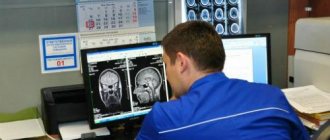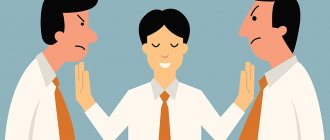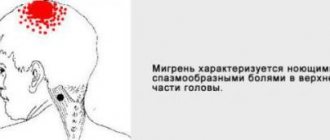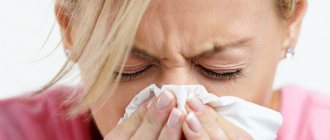Probable causes
Bumps occur anywhere in the human body and are often ignored until a certain point due to lack of time.
A lump that bothers you is the result of a person’s careless attitude towards their health. or small size.
The main complaint upon treatment is usually the word hurts, but it cannot become the basis for a reliable diagnosis.
It is necessary to undergo an examination and establish the real cause of the lump.
To determine the etiology, you need to find out the nature and intensity of the pain, conduct an external examination, and do laboratory tests.
The appearance of a lump may be due to:
- folliculitis (an inflammatory process that leads to the formation of an abscess, abscess or abscess);
- atheroma (which existed before, but now hurts due to the emerging purulent-inflammatory process);
- hemangioma (the cause of which is a pathological plexus of blood vessels and not only on the head);
- fibroma (a benign neoplasm, in some cases capable of transforming into malignant fibrosarcoma);
- lipoma (usually they are painless, and they hurt if they put pressure on blood vessels or nerve endings during the growth process);
- trichoepithelioma (benign neoplasm, sometimes inherited);
- wart (a characteristic sign of damage by the papilloma virus, dormant in the body, arising due to weakened immunity);
- enlarged lymph nodes caused by a general somatic disease of the body;
- osteoma (benign bone cyst).
A tumor (or lump) may also appear in the plural, in which case this is an even more alarming sign.
Small lumps are often the result of a bruise or injury. The bumps may be associated with insect bites.
Physiological seals are accompanied by other characteristic signs (nausea, dizziness, nausea and vomiting if there has been a traumatic brain injury), or they itch and hurt when pressed.
Which doctor should I contact?
If bumps appear on your head, it is recommended to first visit a therapist. The doctor will conduct an initial examination, collect anamnesis and refer you to a specialist. If a formation on the head appears after a blow, then you can initially go to a traumatologist.
Surgeons treat boils and most tumors that need to be removed. When there is a suspicion that a tumor is malignant, oncologists are involved in the work. If the lymph nodes are enlarged, ENT intervention is required. Bumps that occur after contact with an allergen or an insect bite are monitored by an allergist. In the latter case, an infectious disease specialist can be involved in the diagnosis. A dermatologist works with warts and pimples.
Other possible causes of tumors on the head
If you feel a lump behind your ears or on the back of your neck, it could be an enlarged lymph node. Such bumps most often occur in young children, as the immune system adapts in the first months of life. Most often, such a lump grows during infectious diseases and decreased immunity. Such a formation must be shown to an immunologist; he will be able to determine what caused it and prescribe medications for treatment, if necessary.
If skin care is not taken care of, a sebaceous gland cyst may appear. With such a tumor, you must definitely visit a doctor, since you need to have surgery. Among the benign ones are:
- Lipoma is a tumor that is a clot of adipose tissue, or a wen. Rarely it can become malignant, turning into liposarcoma. It is treated on an outpatient basis, by removal under local anesthesia.
- Hemangioma - formed from blood vessels. Has a dark tint. Hemangioma most often appears due to heredity, progression of vascular disease, or exposure to ultraviolet radiation. Treatment methods: cryotherapy, injections, hormonal therapy, removal, radiation, cauterization, electrocoagulation.
- Fibroma is a tumor of connective tissue. Fibroids appear with excessive use of beta blockers, due to hereditary predisposition, diabetes, chronic diseases of the reproductive system, hormonal imbalance, parasites. The fibroid is removed if it causes discomfort and does not pose a threat to life. Treatment is carried out in the form of laser or radiation therapy, surgical removal.
Malignant tumors are like a ball under the skin. They have mobility and often uneven edges, are accompanied by pain and enlarged lymph nodes. Appear on the back of the head, neck and other parts of the head. Surgical treatment, radiation or chemotherapy are carried out.
Osteoma
If a bone lump appears on the back of the head, it may be osteoma.
With this disease, a bone tumor is formed, which is benign in nature. The formation of the cone is slow. The risk group mainly includes children (most often boys) over 4 years of age and young men under 21 years of age. In some cases, the development of the tumor is accompanied by pain. The tumor is spherical, with clear edges, hard, like bone. It occurs due to hereditary predisposition (more than half of cases) or as a result of injury, rheumatism, gout or syphilis. Osteoma does not go away without surgery.
Diagnosis of pathology
Birth injuries are not uncommon. The bones of the skull are subject to enormous stress as they pass through the birth canal. The newborn is carefully examined by a neonatologist, who diagnoses pathology if it is present. To clarify the diagnosis of cephalohematoma, ultrasound, head X-ray and other examinations are performed (we recommend reading:).
It is easiest to identify a hemangioma by its appearance and characteristic red color. In the future, the surgeon should monitor it, monitor its growth and dynamics.
If you find a ball-shaped lump on the back of a child’s head after a bruise, it is better to immediately show it to the doctor. The main criteria that the doctor focuses on during the examination:
- size;
- number of cones;
- location;
- color;
- amount of blood leaked (in case of injury);
- general condition of the patient.
By comparing all the parameters and assessing the possible risk of damage or danger to the brain, the doctor will make an accurate diagnosis. Only with light blows can you do it yourself.
Symptoms
Symptoms are determined depending on the type of formation.
Injury
Painful sensations appear when pressed, redness and swelling occur. With more serious injuries, which indicate a closed craniocerebral injury, the following symptoms occur:
- Loss of consciousness occurs immediately after the injury. At this time, the patient does not respond to external stimuli and does not feel pain.
- Pain in different parts of the head - begins immediately after regaining consciousness.
- Nausea and vomiting do not give a feeling of relief.
- Dizziness.
- Hematoma - most often occurs with fractures of the bone frame of the skull. You can often observe the ear and near the eyes.
- The face and neck become red.
- Amnesia - a person does not remember events that happened before the injury (occasionally there are cases when a person forgets events that happened after the injury).
- Development of convulsive syndrome.
- Increased sweating.
What to do if a child has a lump on the back of his head?
- Causes
- Symptoms
- Treatment methods
A lump is a subcutaneous neoplasm related to a benign tumor. If the defect appears as a result of mechanical damage, then it is not a tumor, but a bulge consisting of lymph and blood.
Parents of active children often notice that their child develops bumps only on the head, and on an arm or leg, even with strong blows, only a bruise. The fact is that when damage occurs to the extremities, blood and intercellular fluid are quickly distributed in the subcutaneous fatty tissue.
There is no such layer on the head, so after damage to the blood vessels, the blood has nowhere to go except to be localized between the skull and skin in the form of a lump.
Causes
The tumor may feel soft or hard to the touch. After falling or hitting a sharp corner of furniture, hard swellings form. If the consistency is soft, a benign tumor (cyst) can be assumed. If the lump on the back of the child’s head was not caused by a blow, then it may be the following types of neoplasms:
- Lipoma;
- Fibroma;
- Wart;
- Atheroma;
- Osteoma;
- Furuncle;
- Hemangioma;
- pilar cyst;
- Cephalohematoma;
- Enlarged lymph nodes;
- Insect bite;
- Allergic reaction;
- Mechanical injury.
The name wen is also common among people. A neoplasm consisting of a sebaceous mass. Lipoma can be effectively treated with folk remedies. A paste of laundry soap and boiled onions is used. Fibroma looks like a dense ball on a stalk.
An excellent remedy for resolving fibroids consists of beet juice and golden mustache. In some cases, specialists prescribe removal. Warts are removed using modern hardware techniques using laser, electrical stimulation, and liquid nitrogen. A pilar cyst is formed as a result of a blockage of the sebaceous duct.
With prolonged accumulation of fat, a hard lump grows on the back of the child's head. Osteoma is a benign bone growth in the form of a lump on a baby's head. Characterized by regular shape, hard to the touch. The child does not complain of pain.
Cephalohematoma is a common tumor among newborns - this is a small tumor in which blood accumulates. The reason is the difficult birth process, in which doctors use forceps to wrap around the baby's head.
Note!
Hemangioma is a dangerous formation. It can degenerate into a malignant tumor. Upon careful examination, the hemangioma is visible through the vascular network. Surgeons remove the tumor and send the contents to a histology laboratory.
Symptoms
The tumor can form in any part of the head
Particular attention should be paid to swelling at the back of the neck. These neoplasms can lead to serious consequences
It is urgent to take the baby to the clinic. Associated symptoms include:
- nausea;
- vomit;
- strong pain;
- the baby is crying;
- convulsions are present;
- blood flows from the nose and ears;
- there are bruises, bruises, hematomas;
- the injured area is swollen.
The above symptoms indicate that there is a bump on the back of the child’s head after a fall, and a strong blow damaged the skull. As a result, the doctor diagnoses a traumatic brain injury. Concussions also happen. In which the patient also experiences severe nausea, vomiting, and dizziness.
Treatment methods
If a bump forms on the back of the child's head, the child often experiences bruising and bruising from the blow. With such damage, it is necessary to apply a cold compress to the sore spot as quickly as possible. To do this, use ice wrapped in a handkerchief.
The compress is held for about 10 - 15 seconds, then released for 5 - 10 seconds. The procedure is performed over 15 minutes. Such actions will prevent an increase in the hematoma and help reduce swelling. Alternatively, a towel soaked in very cold water or a strong saline solution is acceptable.
For a quick recovery, doctors recommend topical medications. Anti-inflammatory ointments with a resorption effect are used. Among folk methods, the following method is widespread. Twice a day, the lump is wiped with an alcohol solution, and then an iodine mesh is applied.
If you find a lump on the back of the head or forehead of your baby, you need to visit different specialists: a surgeon, a neurosurgeon, an otolaryngologist, an allergist, an oncologist. A conscientious attitude to the treatment of a child and a timely visit to the hospital will allow the pathology to be diagnosed at an early stage and dangerous consequences to be prevented.
Loading…
Treatment of cones
Methods for dealing with bumps on the back of the head are selected individually and depend on the causes of the problem. Treatment options can be very different, and for different diagnoses they give different results. It is extremely important not to self-medicate. Applying heat to a boil will aggravate its course, and combating the consequences of the injury with cold a day after receiving it will slow down the healing process. You should not be afraid of surgical treatment if a specialist insists on it. Sometimes this is the fastest, safest and most effective option for eliminating a lump. Today, laser and cryotherapy are increasingly used to remove tumors. They are able to destroy the formation without compromising the integrity of the skin.
A hard lump on the back of the head does not always pose a danger to human health and life, but it can cause significant discomfort. You should not delay treatment even in cases where the formation does not bother you. Accidentally touching it can damage the integrity of the skin and introduce an infection into the wound. The close location of the abscess to the brain threatens damage to the membranes and substance of the organ. This can lead to serious complications, including death.
Reasons for appearance
There are many reasons why tumors may appear:
- Injuries and bruises. The most common problem after which bulges appear on the head. In this case, a small painful swelling appears, which looks like a growth from the outside.
- Allergic reaction to an insect bite. Depending on the degree of reaction to an insect bite, the neoplasm can be from 5 mm to several centimeters in diameter, accompanied by itching and unpleasant but tolerable sensations. To relieve itching and redness, you will need to use antiallergic medications; you should consult a specialist.
- Inflammation of soft tissues:
- Furuncle (purulent neoplasm, appears from a staphylococcal infection).
- Abscess (subcutaneous accumulation of pus, appears due to a focal bacterial infection).
- Enlarged lymph nodes (inflamed when adenoviral infections penetrate the body).
- Subcutaneous formations:
- Atheroma (cyst). Formed due to blockage of the sebaceous gland, it is painless and can reach the size of a fist. When infected and suppurated, it is accompanied by a feeling of pulsation at the site of the tumor and an increase in temperature.
- Lipoma (fat). Appears due to excess fat deposition in the skin, consists of fat cells and does not cause pain.
- Wart. Caused by the human papillomavirus, it usually appears on the head due to weakened immunity.
- Fibroma, sarcofibroma. Fibroma is hard to the touch and is itself a benign tumor. Sarcofibroma is malignant.
- Osteoma (benign tumor formed from bone tissue).
Why do they appear?
There are many reasons for the formation of bumps on the back of the head.
- This can often happen due to bruises or blows.
- Another cause of the tumor may be illness.
- In children, balls on the back of the head may appear during puberty.
- In infants, this may be an allergic reaction to a change in the composition of the mother's milk, or inflammation of the lymph nodes due to weak immunity.
If a lump appears on the scalp, you should consult a doctor to find out the source of its origin.
Types of tumors on the head and their signs
Hemangioma
A large growth on the head that occurs when the circulatory system is disrupted. The veins can grow uncontrollably, resulting in a red lump. Under the tubercle you can see a network of blood vessels. Doctors consider hemangioma the most dangerous type of tumor.
It is the hemangioma that leads to disruption and formation of the surrounding tissues of the head. Often this type of tumor is located under the hair. A small hemangioma can grow in size over time and become a malignant tumor. If a hemangioma emerges, you must seek specialized medical help.
Allergic reaction
A bump on the head occurs when the human body is exposed to certain allergens. An allergic reaction is caused by food, household chemicals or cosmetics. Such bumps itch and bring a lot of unpleasant sensations to a person. To avoid the formation of such bumps, you should optimize your diet and buy products only from trusted manufacturers.
Fibroma and sarcofibroma
Fibroma is a benign tumor. It consists of connective tissues of the scalp. Fibroids appear on the back of the head, forehead and other parts of the body. In an adult, the tumor can reach significant sizes. The main factors that provoke the occurrence of fibroids: heredity, diabetes or hormonal imbalance. Fibrosarcoma has similar causes, but is a malignant tumor. If left untreated, it leads to death. Most often, fibroma is hard to the touch and does not cause pain to a person.
Lipoma on the head
Lipomas form on damaged human fatty tissues. These are benign tumors. Women over 30 years of age are susceptible to developing growths. Frequent changes in hormonal levels and impaired fat metabolism lead to the formation of lipomas. Such tumors develop both on the head and on other parts of the body. The lipoma is round in shape and soft to the touch. It can be detected in the hair on the back of the head.
Pimples and bites
A person can detect the presence of a lump if it is bothersome and itchy. It could be a bite or acne. Occurs due to poor hygiene or inflammation of the scalp. It does not require specialized medical treatment and goes away on its own within a few days. To speed up healing, you can use compresses or creams.
Bruise or injury
The human body is often susceptible to various types of bruises. And the head is no exception. With a severe bruise, a tubercle forms, which is very painful when touched. This lump is distinguished by its red color and swelling. Heals on average within a few days. If the headache does not go away, you should visit a specialist. This will help rule out traumatic brain injuries.
A wart is a benign tumor that reaches a significant size. This brings a person a lot of unpleasant sensations, in particular due to appearance. The main factors that provoke the development of warts: hormonal imbalance, inflammation and mechanical damage. Warts, in addition to their slow growth, are capable of multiplying and occupying a significant part of the skin. The cone itself resembles a small brown ball. It's not painful. The wart is constantly growing and reaches 0.5 cm in diameter.
Atheroma on the head
Atheroma is growths on the skin. They occur at any age. Both men and women suffer from this disease. It occurs due to blockage and obstruction of the sebaceous glands on the head. Atheroma has a convex and smooth surface, most often yellow. If atheromas are not removed, they hurt and cause discomfort. Lipoma and atheroma are very similar in appearance, so only a doctor can make an accurate diagnosis after diagnosis.
Wen on the head
A lump on the head is a hard, round tumor. Wen forms over the human skin. Fatty spots occur due to hormonal imbalances and frequent stressful situations. They usually have a non-infectious etiology. If the wen interferes with a comfortable life (clings to clothing), it is removed. Removal takes place in a hospital under the supervision of a doctor.
Childhood is a wonderful time, you can play and fool around, ride a bike and climb trees. Of course, most fun games don't come without bruises, scrapes and bumps. What to do if a child falls and hits his head? Or you found a bump on the head, but the baby did not fall. Should I worry and when should I consult a doctor?
Types of formations
What are these balls that appear under the scalp of children and adults, including on the back of the head? What might their appearance indicate? Let us consider in detail which diseases are accompanied by such symptoms.
Zhiroviki
Benign formations under the skin are called wen. Their size can be from 2-3 mm to several cm.
Wen are characterized as follows:
- Forms under the skin over a long period of time. Then it begins to appear in the form of a small ball, noticeable to the touch.
- When touched and pressed, the wen does not cause any unpleasant sensations.
- The appearance of a wen can occur anywhere in the location of adipose tissue.
The vast majority of lumps are benign neoplasms, and only in rare cases can growing lumps affect a person’s well-being.
Lipoma
Lipoma is one of the most benign neoplasms .
The source of the disease is the adipose tissue of the human body. Lipoma usually appears in the subcutaneous fat of the back, neck, limbs, as well as in internal organs, meninges, heart cavities, and retroperitoneal space. This arrangement can be very dangerous, as there is a risk of compression of organs and tissues. Lipomas located in body cavities have a tendency to malignancy.
Upon examination, the lipoma looks like a small node, clearly felt upon palpation, not connected with the surrounding tissues and does not damage them. It is usually soft to the touch, but as the volume of connective tissue increases, it becomes stiffer (fibrolipoma).
The blood supply to the lipoma is increased . A large number of newly formed vessels makes it possible to distinguish its type - angiolipoma.
The dimensions sometimes exceed 3-5 cm, but painless growth can lead to the formation of a node up to 10 cm or more. Usually, it is the location of these formations in open areas of the body that forces the patient to seek medical help.
Atheroma
Atheroma - translated from Greek means “soft tumor”, sebaceous gland cyst . When manifested, it closes the ducts of the sebaceous gland and prevents its normal functioning. It looks like a small subcutaneous growth that is soft to the touch and does not cause pain. Usually appears under the skin with hair.
Characteristic signs of atheroma:
clear convexity, dense and elastic;- when pressed, it moves to the side;
- the sebaceous duct in the center of the cyst is clearly visible.
In case of inflammation, atheroma is diagnosed by a doctor based on the following signs::
- painful sensations when touched;
- redness and slight swelling in the area of the cyst;
- frequent cases of breakthrough of purulent masses.
Hygromas
Hygroma is an encysted formation in the form of a tumor, filled with serous-fibrinous or serous-mucosal fluid. It is a benign cystic tumor. Most often it is located in the area of the wrist joint, on the hand, in the area of the foot and ankle joint. The main reasons are unhealthy heredity and injury.
Small hygromas, as a rule, do not cause any discomfort. When they grow or are near nerve endings, pain or decreased sensitivity may appear. Hygromas never progress to the malignant stage of development . They do not pose a danger to life.
To treat hygroma, a surgical method is used - removal. Treatment with drugs in this case practically does not bring results.
Purulent and inflammatory formations
Purulent formations appear both on the face and on the scalp.
Most often, they are caused by gram-positive anaerobic bacteria. Mechanical impact on the rash causes severe pain. The danger of ulcers lies in their possible complications and the formation of ulcers . Before starting treatment, it is necessary to find out the cause of the disease and only then select the necessary therapy. Correct diagnosis contributes to a faster recovery.
Most often, the appearance and development of purulent rashes is influenced by the following factors:
- hormonal imbalance (age-related or cyclical);
- excessive activity of the sebaceous glands on the head;
- diseases of the nervous system;
- polycystic ovary syndrome;
- adrenal gland diseases;
- infections that manifest themselves against the background of damage to the skin.
External factors cause the appearance of ulcers on the scalp:
- taking anabolic steroids or hormonal drugs;
- a large amount of carbohydrates in consumed foods;
- neglect of personal hygiene rules;
- a large amount of chlorine in water for washing hair;
- allergic reaction to hair care cosmetics;
- alcohol and tobacco abuse;
- allergic reaction;
- pillows and combs made of synthetic materials;
- negative effects of low temperature on the scalp.
Malignant growths
Malignant growths are skin cancers.
- Melanoma . It looks like a flat formation with a rough surface. Melanoma grows rapidly with subsequent metastases.
- Basalioma . Outwardly, it looks like a white knot, covered with a crust on top. If the diagnosis is not made in time and treatment is not started, it develops into squamous cell carcinoma of the scalp.
- Epithelioma . Another one of the malignant tumors. With this disease, metastases very quickly spread to the lymph nodes, so it is also considered one of the most dangerous.
Causes of skin diseases
Scalp diseases can be caused by the following:
- weakened immune system;
- nervous overstrain, mental illness;
- metabolic disorders in the body;
- lack of personal hygiene;
- infectious diseases;
- unbalanced diet, lack of vitamins;
- incorrectly selected shampoos and conditioners;
- fungal diseases of the scalp;
- allergy;
- hereditary diseases;
- disturbed ecology;
- abuse of chemicals;
- damage to the scalp as a result of bruises, as well as from iron hairpins.
Expert opinion Zemlyanukhina Tatyana Vyacheslavovna Ambulance and emergency medical assistant at the Emergency Clinical Hospital #7 in Volgograd.
Ask an expert
Particular attention should be paid to mycoses. Since fungal diseases are very common on human hair, especially on the head, where there is most hair
You can easily catch a fungal infection just by leaning on the headrest in a taxi. The fungus is often disguised as ordinary dandruff and you may not know about its presence for many years. At the first problem with your scalp, be sure to contact a specialist.
Dry seborrhea
If there is a lack of activity in the sebaceous glands, dry seborrhea can occur. The reason is not only low sebum production, but also:
- stress, anxiety, psychological shocks;
- hereditary factors;
- hormonal disruptions (puberty or abnormalities in the functioning of the glands);
- use of incorrectly selected cosmetics, as well as cosmetic paints with ammonia;
- poor hygiene, excessively frequent hair washing and blow-drying;
- lack of vitamins (this affects the general health and functioning of the glands).
A deficiency of sebum contributes to the appearance of inflammatory processes on the scalp, which provoke the proliferation of Malassezia fungi. Symptoms of dry seborrhea:
- discoloration, dryness and brittleness of hair;
- formation of cracks in the epidermis;
- the appearance of large scales that quickly peel off.
If measures are not taken, dry seborrhea moves into the next stage. In addition to dandruff, a person is bothered by redness of the skin and seborrheic spots. Sometimes dry seborrhea is an advanced form of oily seborrhea, in other cases the problem arises on its own.
What is herpes on the scalp?
We recommend reading: Ollin hair dye: review, color palette
This is a fairly common disease that spreads throughout the scalp and has accompanying symptoms:
- ENT diseases.
- Manifestation of inflammation of the lymph nodes on the head and neck.
- Severe rash and itching in the scalp.
- Increase in body temperature to 39 degrees.
- The patient begins to feel sick, vomiting, and loss of appetite.
- There is severe pain in the head.
- There is a loss of strength, the person feels weak.
Many people know that herpes is a viral disease that is quite easily transmitted from person to person. But it is necessary to understand the fact that such a disease develops gradually; it has 4 main stages:
- Initially, a person feels a not entirely pleasant sensation in the place where the herpes will appear. Depending on the individual characteristics of the body, this may be redness, pain, tingling or itching.
- Now there is active inflammation of the scalp. As a result, you can observe painful light blisters, inside of which there is a clear liquid.
- When these bubbles mature, they begin to burst, causing the liquid to flow out. This is a very dangerous time, because in addition to unpleasant sensations, there is a high probability of harmful bacteria and microbes getting into open wounds. Here there will be not only a deterioration in the patient’s condition, but also infection of those people who are around him.
- As a result, a scab appears in the places where the bubbles exploded.
As for the impact of such a disease on the body of an adult, it will be treated only with the use of special medication. As a result, the scab will be able to dry out, its remnants will go away, and the scalp will be renewed. The condition will be worse if the person who has received this disease drinks a lot of alcohol, smokes, or has other bad habits. Those people who have a severely weakened immune system cannot do without thorough treatment, because their disease will be much more difficult to treat.
Mixed seborrhea
Mixed seborrhea has characteristics of dry and oily varieties. In particular, patients note that the skin on the face in the middle part is oily, and on the cheeks it is dry. Especially a lot of fat is released in the areas of the crown, chin, forehead, and nose. In other places the fat content is moderate or insufficient.
Doctors also note that a person may be bothered by dry dandruff and oily skin on the face.
Symptoms of mixed seborrhea:
- inflammatory process on the cheeks, scalp, chin, forehead, chest, nose;
- in the area of inflammation, the skin becomes rough;
- redness, itching;
- increased secretion of sebum on the forehead, but decreased secretion in other areas of the face;
- peeling in the area of increased activity of fat-secreting glands, yellowish or gray scales;
- peeling of dry areas of skin.
All the factors listed above as causes of other types of the disease can provoke mixed seborrhea. Most often the problem is associated with hormonal changes or disruptions. Heredity plays an important role. Stress and anxiety can also contribute to the growth of fungi.
Useful video about the beginning of a baby's life
A baby's lump on the back of the head can be hereditary and appears right from birth, or maybe a little later. According to the teachings of the occult sciences, such a phenomenon indicates cosmic magnetism. A pronounced lump indicates that its owner is capable of greatly influencing others. And the dent indicates a break in the harmonious connection with the world. A lump on the border between the crown and the parietal part indicates the greed of its owner. Is it necessary to get rid of such signs?
Causes
A lump in a child on the back of the head, as a rule, appears due to mechanical impact. In ancient times, such damage was removed using a cold penny, which was applied to the sore spot. Today this practice does not bring results. Previously, the coin was heavier and the metal was more noble. But don't despair. Today there are other ways to get rid of such injuries.
How to get rid of such a problem?
Every home is sure to have iodine, alcohol, salt, oil, egg and thyme. If the bruise is very painful, you need to apply cold to it. Take a piece of meat out of the freezer, wrap it in a cloth and apply it to the sore spot. Don't forget to turn the piece over periodically. Soon you will feel that the pain is receding, and after a while the hematoma will become less large. After a day, you can use a warm compress. It will perfectly relieve swelling. Simply heat salt or an egg or use Thyme Leaves will help with healing. Make a decoction of them and wet your head with it.
We use drugs
If the child does not go away, take “Troxevasin” ointment, which has a resolving effect, or “Rescuer” gel. Treat the hematoma with one of the remedies, and the headache will immediately stop hurting, and after some time everything will go away. However, the child may well have a lipoma. This is what is formed from adipose tissue. Such lumps are usually painless, but their size can put pressure on nerve endings and surrounding tissues. She's not going anywhere on her own. It must be removed. Perhaps this will be done using radio waves (if the lipomas are small). It happens quickly, painlessly and heals soon.
Folk remedies
The cone of Siberian healers is called shishun. They claim that the best remedies for their deliverance are prayer and onions. To do this, you need to take a small onion, bake it in the oven, grind it well and mix thoroughly with one-third of a piece of laundry soap until the mixture becomes homogeneous. Such a compress should be applied to the sore spot and changed three times until the lump on the back of the child’s head softens. At the end of the procedure, an unpleasant odor liquid should pour out. To prevent such shishuns from appearing again, you need to read the conspiracy after sunset on the outgoing moon. Siberian healers also advise adhering to certain postulates so that a bump does not appear on the back of a child’s head. There is no need to scratch your head with your left hand while eating. Avoid cutting your hair during the holidays and twirling your hair. Following such recommendations will not make the child worse. But in any case, you need to visit a doctor and make sure there are no serious diseases.
Lump on the forehead of a baby
The main cause of bumps on the forehead of a baby are mechanical injuries, blows and falls. The formation of a large lump after an impact is normal. Such tumors in most cases do not require seeking specialized medical care. They represent swelling of the soft tissues as a result of a bruise, filling them with blood from damaged vessels and subsequent hematoma rising above the surface of the skin. The bumps on the forehead are the largest, because this is where a large number of small vessels pass. At the same time, this part of the head is more durable compared to the temple or back of the head.
What to do if you have a lump on your child’s forehead
First of all, immediately after a blow or bruise, cold should be applied to the damaged area or lubricated with a special ointment. The hematoma usually resolves completely within three weeks. If this does not happen, then you should seek medical help, as in this case a puncture and removal of the contents may be necessary. In addition, a child who has received a blow to the head for any reason must be carefully observed, noting any unusual moments. With symptoms such as a noticeable decrease in reaction, lethargy, lack of reaction to light and different pupil sizes, sweating, drowsiness, constant moodiness, confusion, you need to consult a doctor. Even more dangerous signs are convulsions, vomiting, loss of consciousness, speech impairment - all this is a reason to immediately call an ambulance, because these symptoms indicate a concussion. In cases of severe injury and a large lump, an x-ray may be taken to ensure there are no cracks in the skull.
Other reasons for the appearance of bumps on the forehead of a baby
Lumps on a child’s forehead may be an individual anatomical feature of the structure of a particular child’s skull. In this case, they are not dangerous and do not require any treatment. Most often, over time, the bump on the forehead smooths out and becomes less noticeable.
There are other types of bumps in infants that can appear on the forehead. These formations include benign tumors, characterized by an unchanged structure and gradual growth. One of the varieties of such tumors is wen (lipoma and atheroma). They can occur on any part of the body, the reason for their appearance is clogging of the sebaceous glands. The distinctive features of these two types of neoplasms are the growth rate, as well as the fact that atheroma suppurates and becomes inflamed much more often. Both of these tumors are treated with surgery.
Another type of benign tumor that occurs on different parts of the body is fibroma. It can reach quite large sizes. The reasons for its appearance are still unknown. This lump does not cause significant harm to health, so if it is small in size, does not grow and does not interfere with normal life, it does not need to be removed. Otherwise, surgery is necessary.









